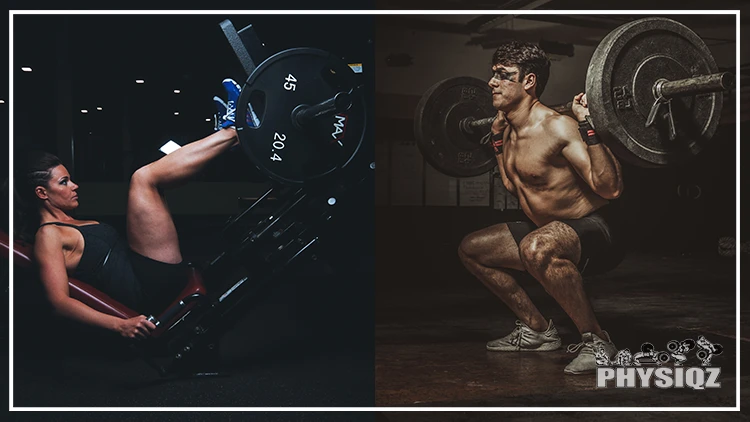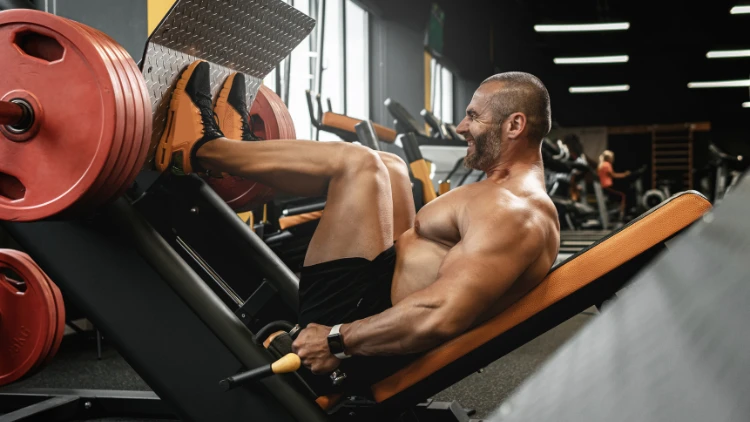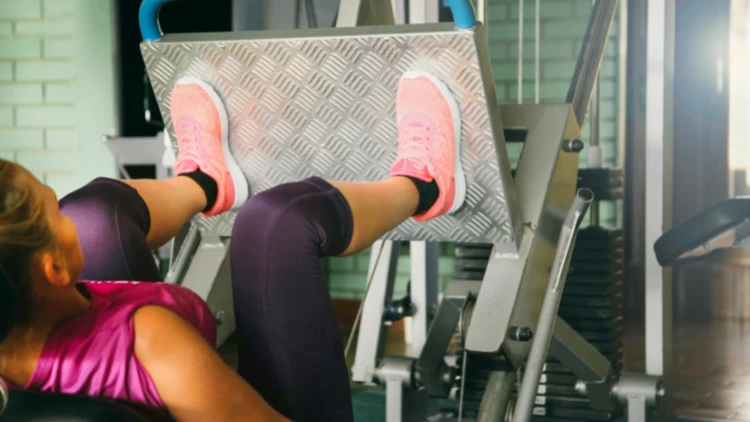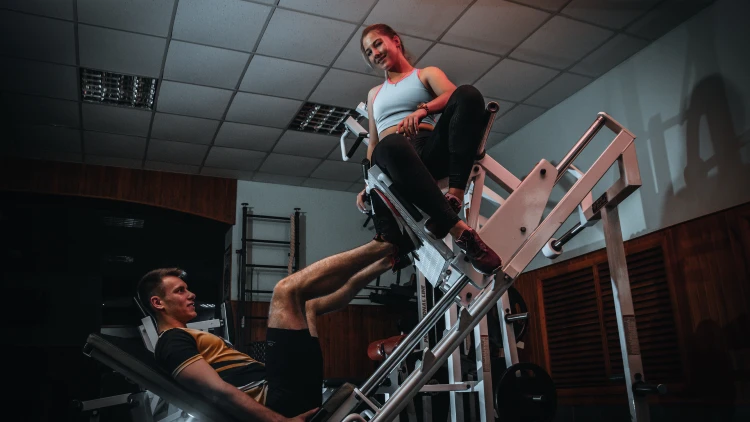
Many gym goers often wonder about the discrepancy between their ability to leg press nearly 2-3 times their squat weight.1 While this accomplishment is impressive, it doesn’t clarify why the leg press feels significantly easier than squats.
The truth is that most people leg press than they squat because a fixed rail system allows for more stability, the angle of leg press vs squat changes the force required to move the weight, and the fact that leg presses takes your back (the limiting factor in squats) out of the equation.
That being said, the simple reason why leg press is easier is because of physics so let’s explore why this is before we cover when to use squats vs leg press, if there is a leg press to squat conversion ratio, and how go from leg presses to squat safety by accurately gauging what weight to use and leaving your ego at home.
Why Is Leg Press Easier Than Squat? Physics! (Among Other Things)
The first culprit for why leg presses are so easy starts with thinking back to high school physics class. The reason I can leg press more than I can squat lies in the design of most leg presses, which typically have a 45-degree angle. This angle reduces the effective weight being pushed, making it easier to lift heavier loads compared to squatting where the weight is fully borne by your body.
When performing a straight up-and-down, vertical lift like a squat, a person is working against the full force of gravity. So when a person squats, they’re squatting 100% of that weight. That’s not the case on the leg press.

Source: A’s Images via Canva.com2
When a person pushes any object at an angle besides the vertical, they only work against a portion of the object’s weight. Pushing an object horizontally removes weight from the equation and reduces the resistance to friction.
Leg presses are usually near-frictionless, so it’s possible to precisely calculate how much weight a person is actually pushing at the leg press.
Simple Formulas Explains Why Machine Leg Presses Are So Easy
For starters, the formula for identifying the weight a person is actually moving at a leg press is:
M x S(A)= W
S stands in for the sine (pronounced sine), which people may remember from trigonometry.
On the other hand, A represents the angle.
While (M) is equal to the mass on the leg press.
So when multiplying the weight by the sine of the angle, the result will be the actual weight a person is pushing on the leg press.
The hardest part of this is finding the sine of the angle, which is going to vary by different angles. However, the most common angle is 45 degrees so it makes sense to start with that.
For a typical 45 degree leg press with near-zero friction, the sine of the angle will be 0.707. That would read as:
M x S(45) = W, or M x 0.707 = W
So, pushing 600 lbs worth of plates on the leg press would boil down to this:
600 lbs x 0.707 = 424.2 lbs
Just because of the angle of the leg press, almost one-third of the weight vanishes. As such, people will be able to leg press at least 1.5 times as much as they can squat.
But wait, it’s common for people to leg press even more than that.
Leg pressing three times a squat or even five times squat weight isn’t unheard of, so while physics is a big part it’s not the whole picture. The reason you can typically lift more weight on the leg press compared to squatting lies in the fact that squats engage all the muscles of your lower body, often revealing that your back muscles are comparatively weaker.
Other Reasons Why Leg Pressing Is Easier Than Squatting
There’s another missing number when it comes to leg press to squat conversion.
While the weight a person pushes on a leg press is less than it seems, a squat’s weight is greater than it looks at first glance. This is because a squat moves the upper body, in addition to the weight of the plates and barbell.
Add this to the difference that the leg press angle makes, and it makes sense that people often leg press more than twice what they squat. But there’s still a missing piece of the puzzle, since these two numbers don’t explain why some people can even leg press three times what they can squat.
At the end of the day, the squat is simply much more complex and back intensive than it seems while the leg press is a simple exercise that involves nearly zero back strength.

Source: Milan Markovic via Canva.com3
Certainly, maintaining the correct squat bar path and understanding how your genetics influence your squat form are crucial for executing the squat correctly.
Good form isn’t just about discipline, but about developing strong supporting muscles as well as muscle memory.
The leg press eliminates all of that and only works the powerful quad muscles in a simple, linear motion. These differences between the leg press and squat mean that squats are much more demanding.
Squats Are a Compound Exercise & They’re More Stimulating & Beneficial Than the Leg Press
Squats and other compound exercises, that is movements that engage multiple muscle groups, are the most beneficial and stimulating exercises for all purposes.
There are several reasons for this, such as the fact they contribute more to quality of life by strengthening supporting muscles and that they improve balance. However, they also just beat isolating movements when it comes to stimulating muscle size and strength gains.
While it might make sense that an exercise that targets a specific muscle group would strengthen that muscle more, it’s actually not the case.
The body’s hormonal response to compound exercises is considerably greater, which results in greater gains.4 Not to mention, high-intensity barbell squats shine when it comes to producing high levels of hormonal benefits.5
This mostly bears out for practical strength, although there are specific use cases for the leg press. A study compared functional outcomes between squats and leg press and found that those who trained partly or wholly on the leg press had better dynamic balance.6
Meanwhile, those who trained partly or wholly with squats had greater strength gains as well as better performance in other technical skills. Take note that the group who trained with both movements was always equal or better than the groups that only trained with one movement.
Another study tested leg presses vs squats for strength and speed-strength outcomes and found the squat generally superior.7 It compared groups that trained on either, but not both, and found that different dynamic motions saw considerable gains from squats while leg presses did not generate statistically significant improvements.
Overall, the squat beats the leg press out for transference to athletic skills.
Squats are more difficult and more rewarding than the leg press, for the most part.
However, that doesn’t mean that doing leg presses is wrong, or that the leg press doesn’t have its own niche as an exercise. They’re useful to overload the muscles and come closer to muscle failure, which can be a method for pushing through a plateau and achieving greater gains.
Plus, some people simply can’t do squats because of weaknesses or injuries in their supporting muscles.
Performing squats with poor form can lead to a sports hernia or other injuries. While getting injured doing leg presses is also possible, good leg press form is easier to maintain than good squat form.
Ultimately, squats and leg presses are fundamentally distinct exercises, and focusing on the question of why one can lift more weight in a leg press than in a squat overlooks this key difference. Conversion and transference between the two is always going to be limited, even though they both mainly rely on leg strength.
Back & Core Strength Are Necessary for Squats Unlike the Leg Press: Muscles Used in Leg Press vs Squats
The squat is a compound exercise because it engages multiple muscle groups across the entire body. In contrast, the leg press primarily targets the quadriceps and calf muscles.
Besides the quad and calves, squats train major back muscles such as the lats and the spinal erector muscles. Differences such as high bar vs low bar squat will shift the emphasis to different muscles within this group, but free weight front squats and back squats will all engage and strengthen these muscles if done properly.
When it comes to improving and maintaining quality of life, strong spinal erector muscles are one of the most important potential results of a strength training program.
Thoracic extension strength (the ability to hold the spine straight and upright with a weight pushing against it) wards off back pain and helps a person maintain good posture when sitting. Back squats are uniquely suited to building a strong back, but the leg press doesn’t engage these muscles at all.
Use Cases for Squats vs Use Case for Leg Presses Since They’re “Easier”
Squats are more difficult than leg presses and more rewarding, but it’s important to understand that no exercise replaces another. There’s truth in saying that the squat is better than the leg press, but there’s more truth in saying that they’re two different exercises.
What’s important is that lifters understand how the benefits of each exercise applies to them and use each accordingly.
What Squats Are Good for & When
The squat is a highly functional, compound movement with great hormonal benefits. This means that it’s great for hypertrophy and strength gains in the quads, glutes, and the core.
It can seem intimidating at first, but there are different styles of squats that can work with low weights to adapt the squat to any skill level.
What all of this boils down to is that the squat is the backbone of any workout routine, as it’s great for building holistic strength improving the results of the whole day. However, being a compound exercise means that squatting relies on many muscles contributing, and when any one of them reaches exhaustion it’s impossible to safely push the others further.
That’s where isolation exercises like the leg press come in.
When To Use the Leg Press
The leg press is a great isolating exercise that’s useful on plenty of fronts.
It’s an easy, approachable exercise that can help beginners ease into training without immediately jumping into challenging free weight exercises. Plus, safety risks on the leg press are low unless a person gets into extremely high weight ranges and watch out for your leg press foot placement because it also matters.
That said, the leg press isn’t just for beginners. A few sets of leg presses can be a great warmup to help performance on more substantial leg exercises, and it can also be a follow-up to something like squats.

Source: Andrej Podobedov via Canva.com8
If someone does a full routine of squats and finds that their legs aren’t quite exhausted, using the leg press to overload the quads is a good idea.
Is There a Leg Press To Squat Conversion Ratio?
There’s no leg press to squat conversion ratio because the exercises are so different.
While it’s possible to calculate leg press weight to squat weight, every person’s body weight and proportions mean that their total squat weight is unique. A 2:1 ratio of leg press to squat is a good goal to have, but what’s more interesting is trying to find a formula to describe the conversion more accurately.
Accounting for Bodyweight & Whole-Body Strength in Leg Press vs Squat Conversion
M x S(A)= W describes the real weight of a leg press, but a squat also has extra weight since a person is moving their body. Depending on their proportions, the exact figure is going to be somewhere around 70% of their bodyweight.
So, add a new figure to the formula, B for a person’s body weight and subtract that from the leg press weight.
M x S(A) – (B x 0.7) = W
Imagine a person who weighs 200 lbs and leg presses 600 lbs on a 45 degree angle leg press.
Multiplying M=600 by the sine of a 45 degree angle leg press (70.7) will get 424 lbs, and then subtracting 70% of their body weight (140 lbs) will result in W=284.
As a result, their legs should have more than enough strength to handle a 280 lb squat.
However, there’s no way to reduce whole-body strength and coordination to a formula. Core and back strength largely account for why someone might be able to leg press more than they can squat, although core strength doesn’t follow strict mathematical rules.
This is why people should take the following guidelines to transition safely from the leg press to squat, rather than overdoing it with heavy weights and risking injury.
How To Safely Transition From Leg Press To Squat
No matter how much someone has trained the leg press, they aren’t going to be fully prepared for squats.
The first time someone goes under the squat bar, they should lower the weight radically compared to their leg press performance. Choosing 1/5ths of their leg press weight is a good starting point that has a low risk of overwhelming their core strength.
From here, there’s a time-tested approach to transitioning to a new lift. A person should attempt to do a full set of 12 reps with perfect form, and if they can do that then they can increase the weight.
Taking this slower approach to progressive overload training will still produce gains, but it’s safer than trying to overdo the weight immediately.9
Leave the ego at the door and put safety first. Be extra safe by finding someone who’s experienced at squatting to spot, so they can point out any mistakes in form as well as any bad habits that might cause injury.
Don’t try to work to exhaustion or near-failure until after months of training the squat. At first, building mind-muscle connection and improving technique is what’s most important.
For those first few months, getting a bit sore or feeling reasonably stimulated is enough.
People often find themselves able to leg press more weight than they can squat. This difference is primarily due to factors such as physics, overall body strength, and body weight.
Frequently Asked Questions
Is Leg Press Considered a Compound Exercise?
The leg press is not a compound exercise. Rather, it’s an isolating exercise that targets the quads and calves.
Why Can I Lift More on the Leg Press Than When Squatting at the Gym?
When someone pushes a weight on a typical 45 degree angle leg press, they only actually push 70% of the weight. Plus, a squat is a more complicated motion that relies on many supporting muscles and also has to lift the weight of the upper body. It’s normal to leg press two or three times what a person can squat.
Does the Leg Press Help You Squat More? Does Squatting Help You Leg Press More? Do They Carry Over?
Squatting and leg press transfer to each other somewhat, since there’s some overlap between the muscle groups. Squats will help a person leg press more since they strengthen the legs, but the leg press will only help a person squat more if that person also works on their core and back strength.
References
1kb group. Canva. Accessed 19 April 2023. <https://www.canva.com/photos/MAD6D_eaqug-athletic-woman-doing-leg-press-in-the-dark/>
2A’s Images. Canva. Accessed 19 April 2023. <https://www.canva.com/photos/MAE2-gMUdmQ-bodybuilder-doing-a-seated-leg-press-exercise-in-a-gym/>
3Markovic, Milan. Canva. Accessed 19 April 2023. <https://www.canva.com/photos/MADIpgI3Msw-woman-in-gym-leg-press-exercise/>
4Shaner, A. A. (2014, April). The acute hormonal response to free weight and machine weight resistance exercise. NCBI. Accessed December 15th, from <https://pubmed.ncbi.nlm.nih.gov/24276305/>
5Wilk, M. (2018, October). Endocrine response to high intensity barbell squats performed with constant movement tempo and variable training volume. NCBI. Accessed December 15th, from <https://pubmed.ncbi.nlm.nih.gov/30531700/>
6Rossi, F. E. (2016, October). Strength, body composition, and functional outcomes in the squat versus leg press exercises. NCBI. Accessed December 15th, from <https://pubmed.ncbi.nlm.nih.gov/27735888/>
7Wirth, K. (2016, May). The Impact of Back Squat and Leg-Press Exercises on Maximal Strength and Speed-Strength Parameters. NCBI. Accessed December 15th, from <https://pubmed.ncbi.nlm.nih.gov/26439782/>
8Podobedov, Andrej. “Free Image on Pixabay – Man, Woman, Workout, Fitness Models.” Pixabay, 8 January 2021. Accessed 19 April 2023. <https://pixabay.com/photos/man-woman-workout-fitness-models-5886580/>
9Peterson, M. D. (2010, November). Progression of volume load and muscular adaptation during resistance exercise. NCBI. Accessed December 21st, from <https://www.ncbi.nlm.nih.gov/pmc/articles/PMC4215195/>